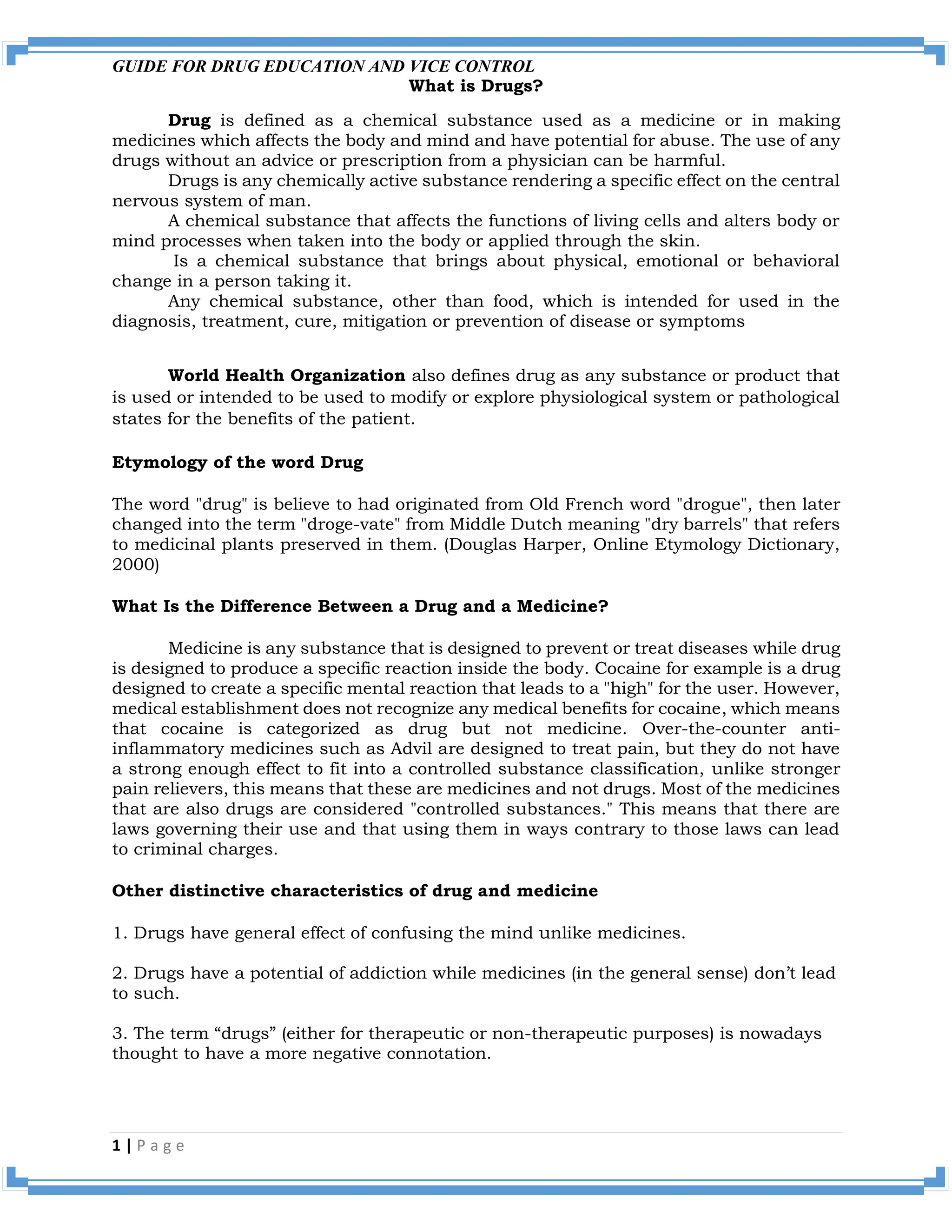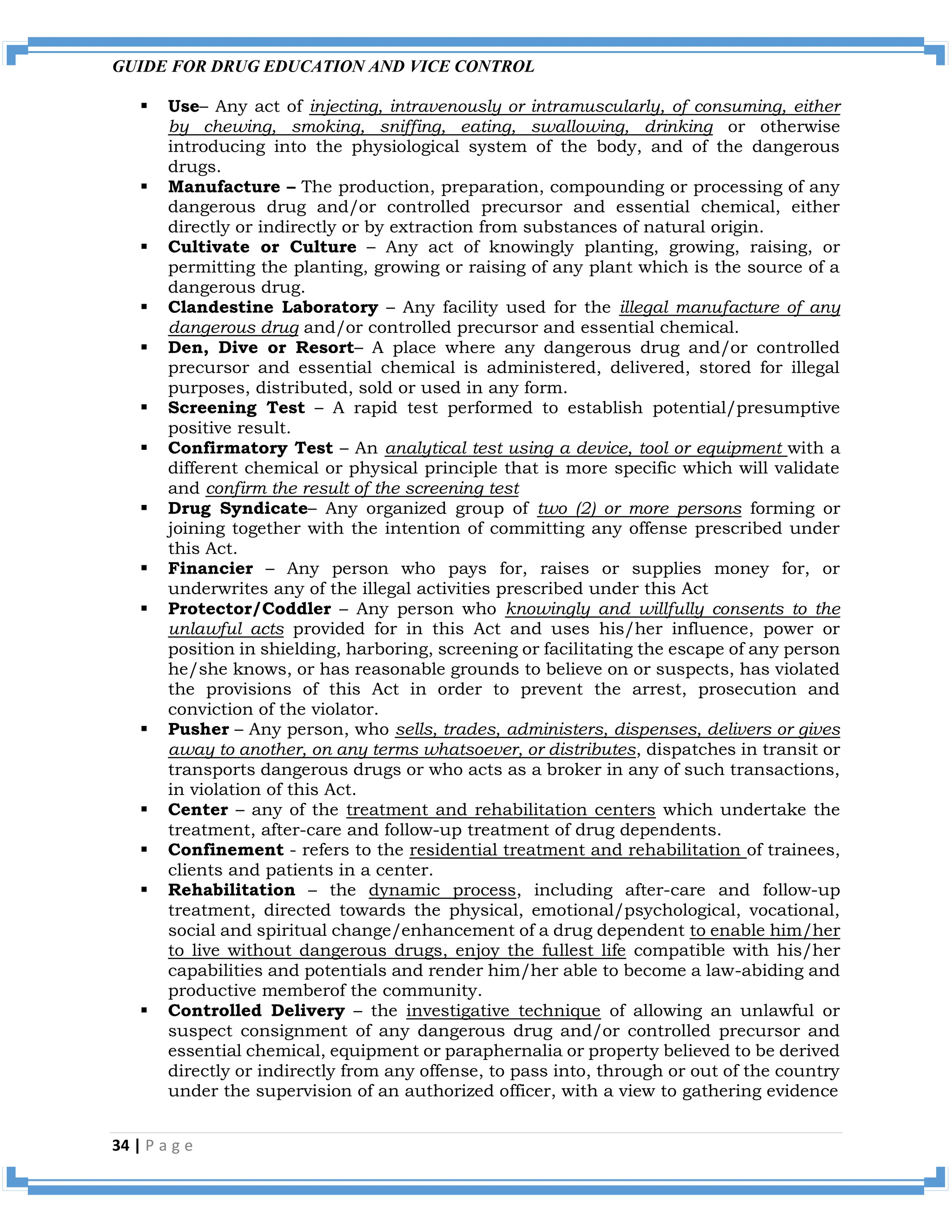This document provides information about drugs and their classification. It defines drugs and distinguishes them from medicines. Drugs are classified based on their effects into depressants, stimulants, hallucinogens, and inhalants. Depressants are then discussed in more detail, including both legal depressants like alcohol and barbiturates, and illegal depressants like GHB and opium. Common names and effects of various depressants are outlined.


![GUIDE FOR DRUG EDUCATION AND VICE CONTROL
3 | P a g e
GENERAL HISTORY OF DRUGS
Drug use and abuse is as old as mankind itself. Human beings have always had
a desire to eat or drink substances that make them feel relaxed, stimulated, or euphoric.
Humans have used drugs of one sort or another for thousands of years. Wine was used
at least from the time of early Egyptians, narcotics from 4000 B.C. and medicinal use
of marijuana has been dated to 2737 B.C in china.
As time went by, Home Remedies were discovered and used to alleviate aches,
pains and other ailments. Most of these preparations were herbs, roots, mushrooms or
fungi. They had to be eaten, drunk, rubbed on the skin, or inhaled to achieve the desired
effect.
One of the oldest records of such medicinal recommendations is found in the
writing of the Chinese scholar-emperor Shen Nung who lived in 2735 BC. He compiled
a book about herbs, a forerunner of the medieval pharmacopoeias that listed all the
then-known medications. He was able to judge the value of some Chinese herbs. For
example, he found that Ch’ang Shan was helpful in treating fevers; Ch’ang Shan is
antimalarial in Chinese medicine and It has emetic effects.
Pre-Columbian Mexicans used many substances varying from tobacco and other
mind-expanding plants in their medicinal collections. The most fascinating among these
substances is the Psilocybin mushroom.
As the centuries unrolled and new civilizations appeared, cultural, artistic,
and medical developments shifted towards the new center of power. A reversal of
traditional botanical drugs occurred in Greece in the fourth century BC, when
Hippocrates who is known as the “Father of Medicine,’’ became interested in inorganic
salts as medications. Hippocrates authority lasted throughout the middle Ages and
reminded alchemists and medical experimenters of the potential of inorganic drugs.
South American Indians, especially those in the Peruvian Andes Mountains made
several early discoveries of drug bearing plants. Two of these plants contain alkaloids of
worldwide importance that have become a modern drugs. They are cocaine, and quinine.
Cocaine ‘s potential for addiction was known and used with sinister intent by South
American Indian chiefs hundreds of years ago.
Sigmund Freud, the Austrian psychoanalyst [1859-1939] treated many deeply
disturbed cocaine addicts. In the course of his practice, he noted the numbing effect of
the drug. He called the attention of the clinical pharmacologist who introduced cocaine
as a local anesthetic into surgical procedures. One interesting truth is that Freud was
a cocaine user himself. Only that cocaine was not yet prohibited during his time, but
was prescribed and used as euphoric. The harmful side of the substance had not been
discovered yet.
During the American Civil War, morphine was used freely by the soldiers during
the war, and those wounded veterans returned home with their kits of morphine and
hypodermic needles and continued to consume the mentioned drug. Cocaine and heroin
were sold as patent medicines in the 19th and early 20th centuries, and marketed as
treatment for a wide variety of ailments. Recreational use of opium was once common](https://image.slidesharecdn.com/guidefordrugeducationandvicecontrol-240415140710-d0b78a38/75/Guide-for-Drug-Education-and-Vice-Control-docx-3-2048.jpg)
![GUIDE FOR DRUG EDUCATION AND VICE CONTROL
4 | P a g e
in Asia and from there spread to the West, peaking in the 19th century, Opium dens
flourished.
Regarding marijuana, another notable herb that has its hallucinogenic effect,
historians credited it [Cannabis Sativa] as the world‘s oldest cultivated plant started by
the Incas of Peru.
GENERAL DRUG CATEGORY
1. Analgesics: Drugs that relieve pain.
There are two main types:
a. non-narcotic analgesics for mild pain, and
b. Narcotic analgesics for severe pain.
2. Antacids: Drugs that relieve indigestion and heartburn by neutralizing stomach
acid.
3. Antihistamines – those that control or combat allergic reactions.
4. Contraceptives – drugs that prevent the meeting of the egg cell and sperm cell
or prevent the ovary from releasing egg cells.
5. Decongestants –those that relieve congestion of the nasal passages.
6. Expectorants – those that can ease the expulsion of mucus and phlegm from the
lungs and the throat.
7. Laxatives – those that stimulate defecation and encourage bowel movement.
8. Sedatives and Tranquilizer – are those that can calm and quiet the nerves and
relieve anxiety without causing depression and clouding of the mind.
9. Vitamins – those substances necessary for normal growth and development and
proper functioning of the body.
10. Antibiotics - are drugs that combat or control infectious organism.
11. Antipyretics – those that can lower body temperature or fever due to infection.](https://image.slidesharecdn.com/guidefordrugeducationandvicecontrol-240415140710-d0b78a38/75/Guide-for-Drug-Education-and-Vice-Control-docx-4-2048.jpg)













































